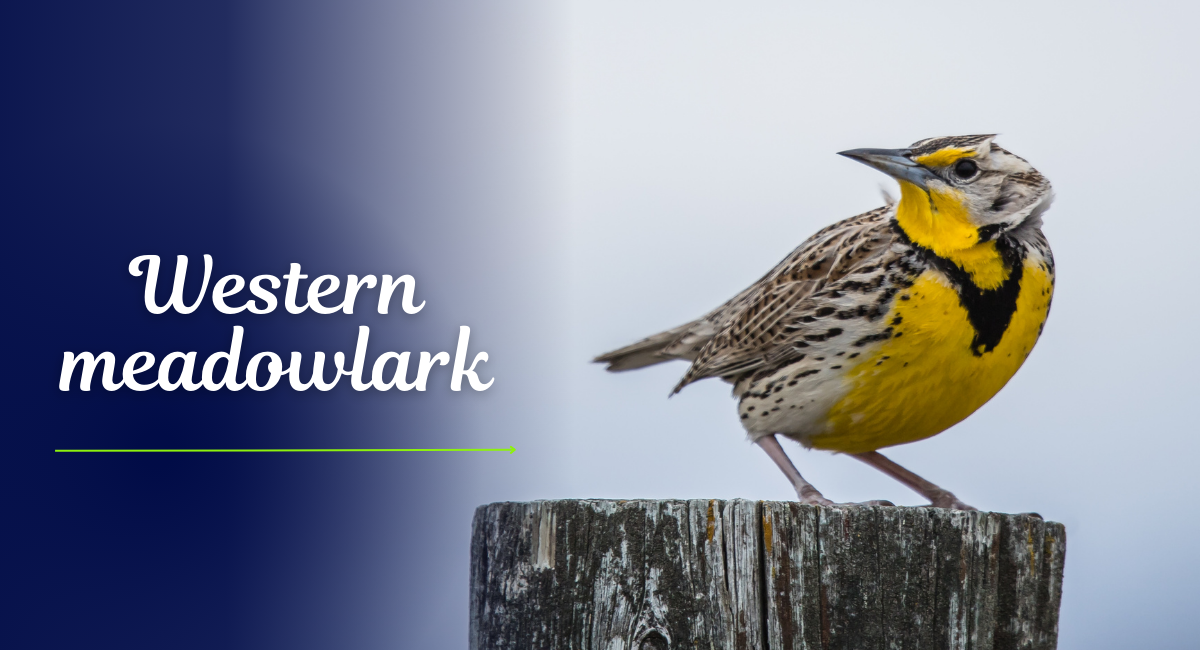The Western Meadowlark: A Symbol of the Grasslands
Physical Characteristics
Measuring approximately 7.5 to 10 inches in length, Western Meadowlarks are medium-sized Singing birds with a stout body and a long tail. Both males and females display striking yellow underparts adorned with black markings, which serve dual purposes: they act as warning signals to potential predators while simultaneously attracting mates during the breeding season. Their brown and black upperparts provide effective camouflage against the grasses and shrubs of their natural habitats, making them well-suited for life in open fields and prairies.
The Western Meadowlark is equipped with a robust, conical bill that is perfectly adapted for its omnivorous diet. This diet includes a wide variety of food sources such as insects, seeds, and small invertebrates, allowing the Singing birds to thrive in diverse seasonal conditions. Their ability to forage for various food types ensures that they can find nourishment throughout the year, adapting to changing environments and food availability. This flexibility is essential for their survival, particularly in areas where food sources may fluctuate.
In addition to their physical adaptations, Western Meadowlarks are known for their social behavior and vocalizations. They often form small groups outside of the breeding season, communicating through their distinctive songs. These melodic calls serve to establish territory and attract mates, showcasing their vibrant presence in the grasslands. As they navigate their environments, these Singing birds contribute to the ecological balance by controlling insect populations and dispersing seeds, highlighting their vital role in grassland ecosystems.
Vocalizations and Behavior
One of the most captivating features of the Western Meadowlark is its vocalization. Males are renowned for their elaborate songs, which they typically sing from a prominent perch, especially during the breeding season. These melodious calls, often described as a series of flutelike notes, can carry over long distances, creating a delightful symphony in the grasslands. The songs serve multiple purposes: they attract females, establish territory, and deter rivals, making vocalization a critical aspect of their breeding behavior.
In addition to their impressive songs, Western Meadowlarks exhibit notable social behavior. They are frequently seen foraging in pairs or small groups, utilizing their robust foraging skills to locate food efficiently. During the breeding season, males engage in elaborate courtship displays, which include singing and hopping to showcase their vitality and fitness to potential mates. This combination of vocalization and physical displays plays a significant role in their reproductive success.
Their social dynamics extend beyond the breeding season as well. Western Meadowlarks often form flocks during migration, creating stunning visual displays as they fly in synchronized patterns across the landscape. These flocking behaviors not only enhance their safety from predators but also strengthen social bonds among individuals. The combination of their beautiful songs and social interactions contributes to the enchanting presence of Western Meadowlarks in their grassland habitats.
Habitat and Distribution
The Western Meadowlark thrives in a diverse array of grassland habitats, including prairies, meadows, pastures, and agricultural fields. They prefer open areas that feature a mix of short and tall grasses, providing ample cover for nesting and foraging. Their distribution spans from the Canadian provinces of Alberta and Saskatchewan, through the Great Plains, and all the way down into Mexico, making them one of the most widespread meadowlark species in North America.
In recent years, Western Meadowlarks have shown a remarkable ability to adapt to human-altered landscapes, particularly agricultural fields where they find abundant food sources. However, this adaptability comes with challenges, as habitat loss due to urbanization, land conversion, and agricultural intensification poses significant threats to their populations. These changes disrupt their nesting sites and foraging opportunities, putting pressure on their survival.
Conservation efforts are critical for the continued success of the Western Meadowlark. Initiatives focus on preserving natural grassland habitats and promoting sustainable farming practices that can coexist with wildlife. By raising awareness about the importance of these habitats and the species that depend on them, conservationists aim to mitigate the impacts of human activity and ensure that future generations can enjoy the melodious songs and vibrant presence of these beloved Singing birds.
Breeding and Nesting
Breeding season for the Western Meadowlark typically begins in late spring, with males establishing territories through their songs and displays. Nests are constructed on the ground, often hidden among tall grasses or dense vegetation, to protect against predators. The female lays a clutch of 3 to 7 eggs, which she incubates for about 12 to 13 days. After hatching, the chicks are altricial, meaning they are dependent on their parents for food and care.
Both parents share the responsibility of feeding their young, primarily providing a diet rich in insects to support rapid growth. The fledging period lasts about 10 to 14 days, after which the young are capable of independent foraging. Western Meadowlarks may have two or more broods in a single breeding season, depending on environmental conditions and food availability.
Conservation Status
The Western Meadowlark is currently classified as a species of “Least Concern” due to its wide distribution and relatively stable population. However, they face significant threats from habitat degradation, particularly in areas where grasslands are converted to agricultural lands or urban developments. Conservation efforts are crucial for maintaining the habitats that these Singing birds rely on for nesting and foraging.
Promoting awareness about the importance of grassland ecosystems and advocating for bird-friendly agricultural practices can significantly impact the preservation of the Western Meadowlark. By creating and maintaining grassland habitats, enthusiasts and conservationists can help ensure that this iconic Singing birds continues to thrive for generations to come.
The Western Meadowlark is a quintessential symbol of the North American grasslands, with its beautiful song and striking appearance. Understanding their habitat, behavior, and conservation needs is vital for preserving this remarkable species. By fostering awareness and supporting habitat conservation, we can contribute to the future of the Western Meadowlark and the diverse ecosystems they inhabit.



